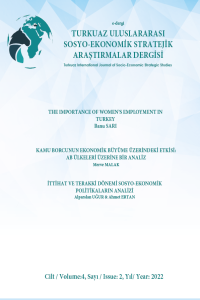OECD ÜLKELERİNDE MALİYE VE PARA POLİTİKALARININ İKTİSADİ BÜYÜMEYE ETKİSİNİN TAHMİN EDİLMESİ: 1996-2021 DÖNEMİ
MALİYE VE PARA POLİTİKALARININ İKTİSADİ BÜYÜMEYE ETKİSİ
Anahtar Kelimeler:
: Fiscal policy, monetary policy, growth, OECD countries, panel fixed effects analysis
Estimating the Effect of Fiscal and Monetary Policies on Economic Growth in OECD Countries: 1996-2021 Period
Theoretical and empirical debates on the impact of fiscal and monetary policies on economic growth are quite old and extensive. This paper examines the monetary and fiscal policies affecting the economic growth of OECD countries between 1996 and 2021. The method of the study is panel data analysis using a fixed effects estimator. The research question of this study is “what is the effect of monetary and fiscal policies on economic growth”, and theoretical and empirical studies in the literature were used to answer this question. Growth was used as the dependent variable for this purpose. As independent variables, an exchange rate and inflation were used to represent monetary policy. Government expenditure and government revenue are used as other independent variables to represent fiscal policy. According to the results of the analysis, monetary and fiscal policies affect economic growth. Hence, while the exchange rate (-0.001) and public expenditure (-0.880) affect economic growth negatively, inflation (0.005) and public income (0.274) affect economic growth positively. However, the coefficients of the variables are different from each other. While the effect of the monetary policy variables used in the analysis on growth is quite small, the coefficients of the fiscal policy variables are large. In addition, in the study, a discussion about which of the monetary and fiscal policy options that became popular, especially in times of crisis is effective, is discussed for the COVID period. Historically, in every crisis period, justice in income distribution deteriorates and inequalities increase.
___
- Afonso, A., Alves, J. & Balhote, R. (2019). Interactions between Monetary and Fiscal Policies. Journal of Applied Economics, 22(1), pp. 132-151.
- Alleyne, K. A., Lewis-Bynoe, D. M., & Moore, W. (2004). An assessment of the growth-enhancing size of government in the Caribbean. Applied econometrics and international development, 4(3), pp.77-94.
- Andersen, L. C., & Jordan, J. L. (1968). Monetary and fiscal actions: A test of their relative importance in economic stabilization. Federal Reserve Bank of St. Louis Review, November.11-24.
- Barro, R. J. (1991). Economic growth in a cross-section of countries. The quarterly journal of economics, 106(2), pp. 407-443.
- Baunsgaard, T., & Symansky, S. (2009). Automatic Fiscal Stabilizers: How Can They Be Enhanced Without Increasing Government Size. SPN/09/23, International Monetary Fund.
- Bennett, H., & Loayza, N. (2002). Policy biases when the monetary and fiscal authorities have different objectives. Banco Central de Chile.
- Bernanke, B. 2016. Monetary Policy in the Future. In Progress and Confusion: The State of Macroeconomic Policy, edited by O. Blanchard, R. Rajan, K. Rogoff, and L. H. Summers, pp. 129–134. Cambridge, MA: The MIT Press.
- Blinder, A. S., & Solow, R. M. (1973). Does fiscal policy matter?. Journal of public economics, 2(4), pp. 319-337. Bottai, Matteo (2003), Confidence Regions When the Fisher Information is Zero. Biometrika 90(1), pp. 73-84.
- Brzoza-Brzezina, M., Kolasa, M., & Makarski, K. (2022). Monetary Policy and COVID-19. International Journal of Central Banking, 18(1), pp. 41-80.
- Correia, I., Farhi, E., Nicolini, J. P., & Teles, P. (2013). Unconventional fiscal policy at the zero bound. American Economic Review, 103(4), pp. 1172-1211.
- Corsetti, G., & Müller, G. J. (2006). Twin deficits: squaring theory, evidence, and common sense. Economic Policy, 21(48), pp. 598-638.
- Driscoll, J. C., & Kraay, A. C. (1998). Consistent covariance matrix estimation with spatially dependent panel data. Review of economics and statistics, 80(4), pp. 549-560.
- Easterly, W., & Rebelo, S. (1993). Fiscal policy and economic growth. Journal of monetary economics, 32(3), pp. 417-458.
- Forte, F., & Magazzino, C. (2016). Government size and economic growth in Italy: a time-series analysis. European Scientific Journal, 12(7), pp. 149-169
- Friedman, M. (1968). The Role of Monetary Policy. American Economic Review, 58 (1), pp. 1-17.
- Friedman, M., & Meiselman, D. (1963). The relative stability of monetary velocity and the investment multiplier in the United States, 1897-1958. In The Commission on Money and Credit, Stabilization Policies (pp. 165- 268). Englewood Cliffs, NJ: Prentice-Hall.
- IMF (2021). Policy Tracker, https://www.imf.org/en/Topics/imf-and-covid19/Policy-Responses-to-COVID-19#T [İndirme Tarihi: 7.06.2022]
- Levin, A., Lin, C. F., & Chu, C. S. J. (2002). Unit root tests in panel data: asymptotic and finite-sample properties. Journal of econometrics, 108(1), pp. 1-24.
- Mehdi, S., & Reza, M., (2011), Effects of Monetary Policy on Industry sector Growth in Iran, European Journal of Experimental Biology, 1(4), pp. 29-40.
- Monacelli, T., & Perotti, R. (2010). Fiscal policy, the real exchange rate and traded goods. The Economic Journal, 120(544), pp. 437-461.
- Mughal, F. A., Aslam, N., Jabbar, M. A., & Ullah, W. (2012). Inflation, inflation uncertainty, and output growth, are they related? A Study on South East Asian Economies, 1960-2010. Journal of Basic and Applied Scientific Research, 2(6), pp. 6108-6114.
- Musyoki, D., Pokhariyal, G. P., & Pundo, M. (2012). The impact of real exchange rate volatility on economic growth: Kenyan evidence. Business and Economic Horizons (BEH), 7(1232-2016-101104), pp. 59-75.
- OECD (2020). Tax and fiscal policy in response to the coronavirus crisis: strengthening confidence and resilience. OECD.
- Başlangıç: 2019
- Yayıncı: Manisa Stratejik Araştırmalar Derneği
Sayıdaki Diğer Makaleler
KULA MENSUCAT FABRİKASI’NIN KULA İKTİSADÎ TARİHİNDEKİ YERİ
ENTELEKTÜEL SERMAYENİN FİRMA PERFORMANSINA ETKİSİ: BİST TURİZM ENDEKSİ ÜZERİNE BİR UYGULAMA
VERGİ DENETİMİNDE ETKİNLİK: TÜRKİYE VE OECD ÜLKELERİ ARASINDA KARŞILAŞTIRMALI ANALİZ
Neslihan KARAKUŞ BÜYÜKBEN, Kamil GÜNGÖR
Z KUŞAĞININ SOSYAL MEDYA BAĞIMLILIĞININ YAŞAM DOYUMU ÜZERİNE ETKİSİ
